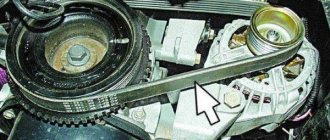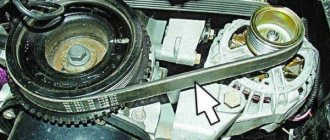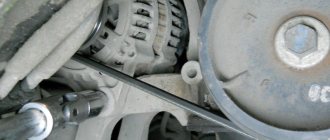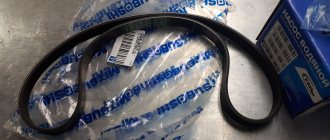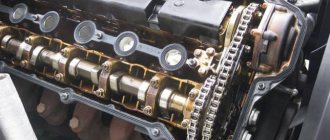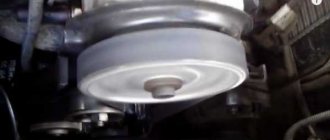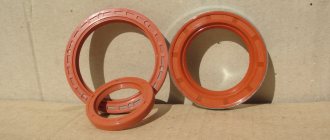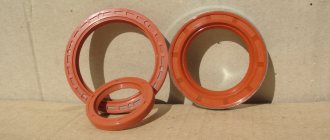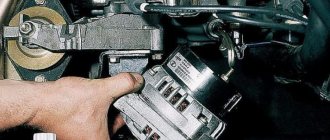Home » Repair tips » Broken timing belt and possible consequences - causes, symptoms, repair 847
In most cases, when the timing belt breaks, a popping noise is heard and the engine stalls, although all other car components continue to function normally. Restarting the engine in this case is most often accompanied by a metallic knock and ease of rotation by the starter, due to the lack of compression in the cylinders.
When the first suspicions arise, you should stop the car and lift the hood to inspect the condition of the belt, if there is such a possibility with quick access, as a rule there is no such possibility.
Why does the timing belt break?
Causes of product damage:
- low quality belt;
- errors made during installation or replacement;
- failure of the tensioner rollers;
- wear of the belt teeth (the teeth wear out constantly during the operation of the car);
- pump jamming;
- foreign objects entering the gas distribution mechanism.
Late replacement
The service life of modern new products for distribution mechanisms depends on the make of the car and is about 150 thousand kilometers (on older cars this figure is lower - about 70 - 100 thousand / km). If the vehicle is used in low temperature conditions, the service life of the belt is reduced to 60-100 thousand/km. In any case, experts recommend diagnosing the condition of the timing belt at least every 15 thousand kilometers.
Quality of spare parts
Quality determines the correct ignition of the air-fuel mixture, which affects the efficiency of the power unit. Installing and using cheap products in the machine can cause low drive tension, which will result in the belt quickly bursting.
Incorrect belt replacement
Errors made when installing the timing belt lead to asynchronous opening and closing of the valves, resulting in reduced engine power. The cause is usually too loose or too high a tension on the shafts. If the replacement of the product was carried out with errors, it may break after 1-2 thousand kilometers.
Characteristic signs of incorrect replacement:
- the product slides to the side;
- cracks have appeared or become noticeable on its surface;
- An unusual sound is heard when the engine is running.
Broken tension rollers
Tensioner rollers are designed to tension the belt on the engine shafts, so that it does not jump off while the engine is running. If the tension is weak, the strap will begin to slip, which will cause an increase in temperature and rapid wear of the auxiliary units. If the tension is excessive, the product can quickly burst, and a characteristic symptom will be a sharp sound from under the hood.
Destruction of timing belt teeth
With serious wear, the rubber teeth located in mesh with the shaft gears break off. With such a problem, the engine may not start, although the belt itself appears to be intact. The operation of the power unit as a result of tooth destruction is disrupted, as this leads to a failure of the ignition system.
Pump wedge
If the pump is jammed, it may not respond to turning, which leads to strong tension and breaking of the belt while the vehicle is moving. This problem is more relevant for domestic vehicles.
Foreign elements
If foreign elements get into the distribution mechanism (this could be dirt, small stones, engine oil), the camshaft or crankshaft may jam. To avoid this problem, it is necessary to periodically check the protective cover and fastenings.
Video: causes of timing belt damage
In the video, user Igor Belov spoke in detail about why the timing belt breaks.
Recommendations
Having figured out what will happen if the timing belt breaks, you can understand the reasons for the concern of many auto mechanics and car owners regarding the correctness and regularity of replacing this element. In this case, much depends both on the quality of the belt itself and on the condition of other elements that are driven by the belt.
More precisely, we are talking about the pump (water pump) of the cooling system. As a rule, about 30-40% of all cases of timing belt breakage are associated with the cooling system pump. The fact is that the life of the pump is relatively short (about 80 thousand km), but many people do not change the water pump when replacing the timing belt after 50-60 thousand.
We also recommend reading the article on how to check the pump on a car without removing it from the engine. From this article you will learn about the features of checking a water pump, as well as how to properly check the pump on a car.
As a result, the pump begins to leak and jams, which leads to a broken belt. For this reason, it is recommended to parallel the standard replacement of the timing belt at 60 thousand km. mileage, simultaneously replace the rollers and pump. This approach will allow you to more accurately calculate the schedule for replacing all elements and significantly reduce the risk of unexpected breakage of the timing belt after its recent replacement.
What are the signs of a broken belt?
You can determine that the timing belt has broken by the following “symptoms”:
- Abrupt stopping of the engine and inability to start it. Attempts to start the power unit only worsen the situation, since the piston causes new damage to the failed valve.
- After a belt breaks, engine operation may be accompanied by a metallic knock and ease of rotation of the crankshaft by the starter. This is due to the lack of compression in the engine cylinders, as a result of which nothing holds the pistons.
Video: how to determine if the timing belt has broken
The video from the Renault Repair channel describes in detail how to independently determine whether the timing belt is damaged or broken.
The timing belt has broken, what will be the consequences? What is “real” to do and how to understand?
There are a lot of questions about the timing belt. The first most popular is - it’s torn, what to do, what the consequences may be. Where to run? Khan's engine? Mostly novice motorists write when the car gets stuck and doesn’t move anywhere. It is impossible to start it, and often this is not recommended at all in case of a break; in general, the driver panics. Today I will try to describe the action plan - both diagnosing and eliminating this malfunction. And you know, sometimes you can run into a decent repair! So read and delve into...
THE CONTENT OF THE ARTICLE
I hope there is no need to explain - what is a timing belt? Well, well - in short, it connects the engine shafts - the crankshaft and the camshaft in a certain sequence - so that when the pistons move up or down, only the necessary valves open or close. This creates the pressure inside the cylinders necessary to ignite the fuel mixture. Without a belt, the engine would not work - this is a fact, this is a very important link in the structure of the engine. Now let's talk about why there might be a break.
What are the consequences of a broken timing belt?
The most serious consequence of a broken timing belt is damage to the valves, as a result of which the car owner is faced with the need to overhaul the unit and restore the gas distribution mechanism. This can happen while the engine is running, when the pistons move continuously from top dead center to bottom dead center. The rupture occurs during the release of gases or fuel injection (at this time the piston moves down). In this case, the movement of the pistons in the cylinder continues and parts of the device collide with each other.
If the timing belt breaks, the extent of the consequences will depend on the characteristics of the engine and the conditions under which the breakdown occurred:
- Due to a broken belt, the camshaft stops rotating, causing the valves to stop in one position. At this moment, the crankshaft continues to move by inertia and the pistons go to the open valves, which immediately bends. On some power units, for example, on the VAZ 2111, 8 cl, the pistons are equipped with special recesses, thanks to which contact with the valves is excluded in the event of a break. But, modern engines are designed to provide the greatest power with a minimum volume, so the pistons do not have recesses.
- If the belt breaks at idle, only a few valves may be damaged. Moreover, the higher the rotation speed of the crankshaft, the higher the likelihood of failure of the guide bushings. This problem causes a major overhaul or replacement of the cylinder head.
- On a diesel engine, the consequences of a broken timing belt will be destruction of the valve, camshaft with bearing elements, cylinder head, connecting rods and pushers. This is due to the design of such motors, due to which the valves have virtually no free play when the piston is in the top dead center position.
- For cars equipped with a Japanese engine, when the timing belt breaks, damage to all valves, breakage of bushings, pistons and cylinder heads are typical. Such malfunctions are typical when the machine is moving at high speed.
How long can you drive on a broken belt?
It is important to know
After the timing belt breaks, you should not attempt to continue driving.
Video: the dangers of a broken timing belt
The video from the Car Program channel describes the consequences that a car owner will face if the timing belt breaks.
Broken timing belt: causes and consequences
Purpose of the timing belt
The timing belt is an important element responsible for the synchronous and harmonious operation of the camshaft and crankshaft of an internal combustion engine. The part is responsible for the function of timely opening and closing of valves. A fully functional belt turns the camshaft at a strictly specified pace - exactly two times slower than the crankshaft turns. During the rotation of the camshaft, a fuel-air mixture (FA) is supplied to the engine cylinders, and exhaust gases are discharged through the exhaust system. A broken timing belt disrupts the entire normal operating cycle of the power unit, and can lead to serious consequences.
Belt drive was introduced by manufacturers to produce lighter and cheaper automobile engines. At the same time, the noise of the running motor has been significantly reduced. But ordinary consumers paid for everything. Innovations in terms of installing the timing belt have brought problems with maintenance and replacement. The service life of a belt drive is much shorter, and during its operation one should constantly “monitor” its condition and tension.
The designers implied that the timing belt itself must simultaneously have high strength, which is close to the chain, and be completely elastic and wear-resistant. As a result of design efforts, a three-layer timing belt design appeared.
Timing belt replacement interval
Even if the engine’s performance is satisfactory, do not forget to timely check the condition of the timing belt, because it also has a wear limit. You can find out this value from the car’s technical passport, but you can do it much simpler: it is recommended to change the spare part every 50 thousand kilometers. If you bought a used car and don't know when it was last replaced, visually inspect the belt. The appearance of microcracks on the body is the first sign of concern.
However, do not panic, because microcracks do not mean that the assembly will break at the first load. Inside it has a metal base made of thin rods. This allows you to withstand impressive shock loads and not tear for a long period of time. On some models, automakers install impact-resistant belts with reinforced metal cord. Thus, it is possible to extend the service life by approximately 30%.
Causes of timing belt breakage
There are several reasons why the timing belt breaks, and to determine them you need to have at least a little understanding of the structure of the power unit. Often, drivers encounter this problem after replacing a belt or repairing the gas distribution mechanism, which is associated with replacing valve guides.
Causes of timing belt breakage
The timing belt is one of the main elements of a car that needs to be serviced promptly and efficiently. In this case, the reasons for a broken timing belt may be the following:
Untimely replacement of the unit. As a rule, the manufacturer recommends replacing the product after 60-70 thousand kilometers. But recommendations may differ - each manufacturer can indicate its own time parameters, which are often more or less than the period we mentioned.
What to do after a belt breaks?
If the timing belt is broken, then:
- It is necessary to open the engine compartment and lift (or completely dismantle) the protective cover of the mechanism.
- It is important to carefully evaluate the appearance of the belt (the torn product will be visible). If it breaks at the very bottom, you will need to turn the crankshaft half a turn to find it.
- The vehicle must then be towed to a garage or service station. If the car is equipped with an automatic transmission, the assistance of a tow truck will be required, since towing is not allowed on such vehicles.
How to replace the timing belt yourself?
Good to know
16-valve engines are equipped with two camshafts with a separate gear for each. Before making a replacement, the user should look in the service manual to see where the timing marks are located and what type they look like.
Algorithm for replacement:
- The engine compartment of the car is opened, the negative terminal is disconnected from the battery (the ignition must first be turned off).
- The wheel is removed from the belt side. To do this, you need to jack up the car and unscrew the bolts with a wheel wrench.
- Then the engine cover and the protection of the power unit are dismantled (the bolts or screws are unscrewed). You will also need to remove the generator drive belt. Depending on the design features of the engine, it may be necessary to dismantle the expansion tank with power steering oil or adsorber. In some cars you need to remove the air conditioner bracket, air intake, intercooler with terminals.
- Using a hexagon, it is necessary to unscrew the bolts securing the protective cover of the strap and gears.
- If the car is equipped with a crankshaft position sensor, it is necessary to disconnect the block with cables from the device.
- Then the timing belt tensioner pulley bolt is unscrewed and the bearing itself is removed. If the system is equipped with a guide or support roller, this must also be removed.
- The worn timing belt is being dismantled.
- The position of the mark on one or two camshaft gears is checked (depending on the 8- or 16-valve engine). It is always important to check that these marks match the marks on the timing drive. If they do not match, you need to combine them with each other yourself. To do this, turn the camshaft with a key.
- If you need to check the alignment of the marks on the gears with the mark on the oil pump body, you must remove the toothed pulley with a special washer. If the screw does not come out, rest the handle of the L-shaped key against the rod, connect the battery and crank the starter once. After this, the battery must be disconnected.
- The next step is to install the support roller, if it is provided for by the engine design.
- The new belt is first placed over the crankshaft sprocket and then wound onto the support roller, camshaft sprocket and pump gear. When performing this task, you should monitor the location of the marks on the camshaft gears. If the risks have gone astray and no longer match, they must be set again.
- Next, install the tension roller and tighten it (you need to screw it without tightening it until it stops).
- Check the evenness of the belt lining. Then it is tightened using a special wrench (the roller must be turned counterclockwise). Next, holding the latter with a tool, you need to fix its position by tightening the mounting screw (all the way).
- The product tension is diagnosed - you need to turn the belt lengthwise using your fingers. It should rotate no more than 90 degrees.
- At the final stage, it is necessary to return all removed parts and spare parts to their places.
- The engine is started and its operation is assessed (by ear). If the product is installed correctly, there should be no abnormal sounds.
When installing the timing belt yourself, it is important to pay attention to:
- the presence of a hum and whistle of the roller, which indicate the belt is overtightened;
- detonation - weakening of its tension;
- black smoke from the exhaust pipe - incorrect markings on the shafts.
Drive Belt Replacement Procedure
Why does the alternator belt whistle when starting the engine or air conditioner?
Now we will tell you how to replace the drive if the timing belt is broken, how and what needs to be done in order to cope with the operation quickly and not do unnecessary things. First of all, before starting work, you should disconnect the battery from your 16-valve engine. If this is not done, then you will face consequences - electric shock, wire burnout during operation, or malfunction of the engine control unit. In order for the valves to take the desired position, and for you to align the marks on the crankshaft and camshaft pulleys, you will have to rotate the crankshaft. After you have aligned the marks in one position, look under the flywheel housing; the mark on it should also coincide with the mark on the housing. If this is not done, the valves will take a non-standard position and then the engine will not even start.
Camshaft gear mark
Now you need to unscrew the generator mount and remove the drive from it. To do this, the generator housing is shifted slightly to the side. At this stage you will have to unscrew the crankshaft pulley; use a suitable wrench to do this. If you can’t unscrew it right away, try to block the rotation of the flywheel to stop the shaft. Just make sure that the teeth on it are not bent - this is a serious breakdown.
Now the only thing left to do is the bypass and tension rollers are held on by bolts. Having unscrewed the latter, loosen the belt tension and remove it. Next, all that remains is to assemble everything in the reverse order, put on a new belt and tension it according to the factory regulations.
To summarize, we recommend that you carefully monitor your car and check 16-valve engines at service stations. After all, you won’t like the consequences of a cliff. And if this happens on the go, then you will have to spend a tidy sum on repairs.
Preventive measures
Good to know
The main preventative measure for timing belt breakage is its timely replacement.
Additional preventive measures include:
- Use of high-quality original spare parts.
- Periodic monitoring of the tension level of the product, the condition of the pump and rollers. It is important that the tension is uniform in all areas, without sagging.
- External assessment of the belt condition. If the first signs of damage and cracks appear on the product, the user needs to replace the timing belt as soon as possible.


